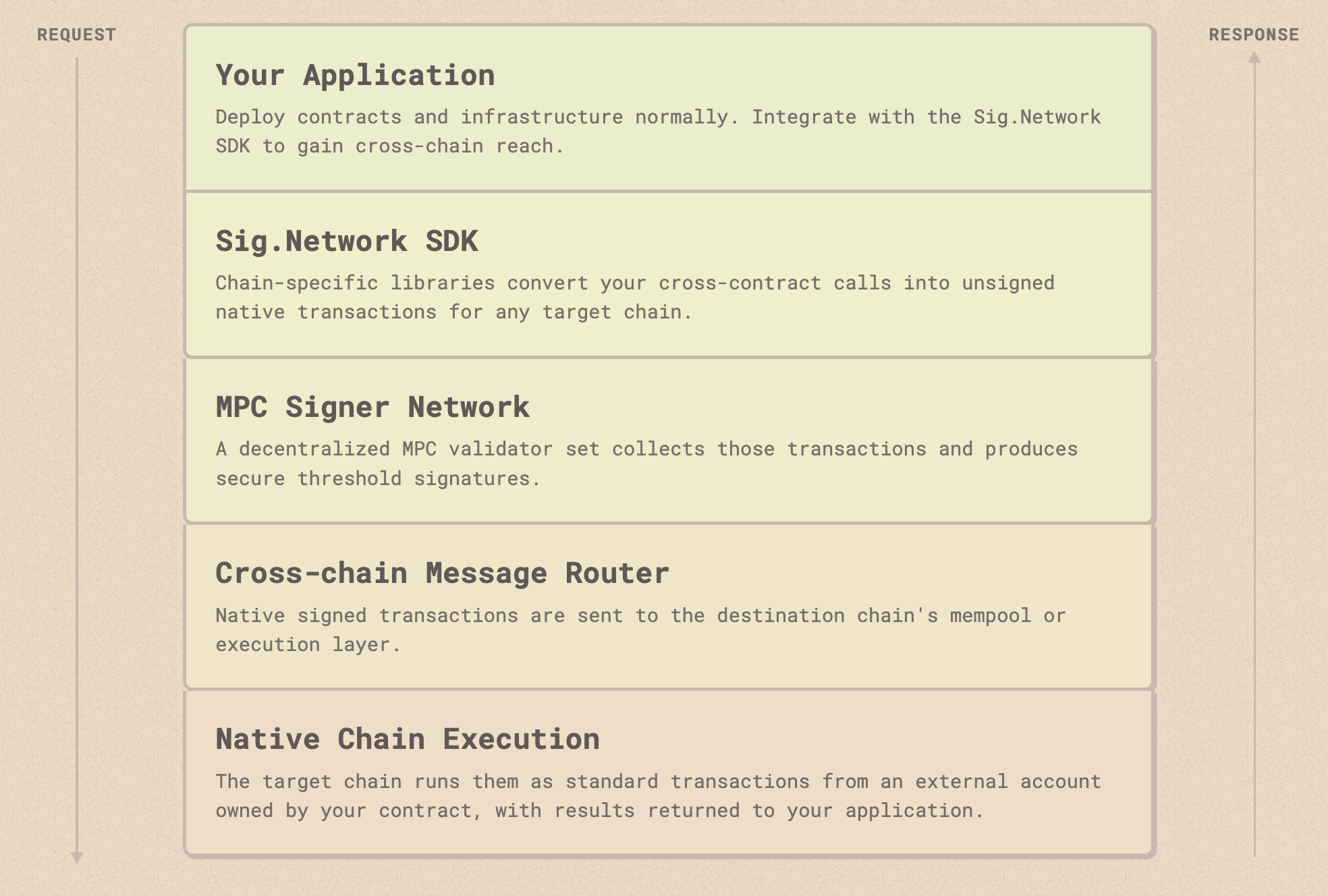If you’ve spent any time building in crypto, you’ve probably felt the drag of multichain deployment. Write one contract, rewrite it for another chain. Refactor, test, secure, and redeploy. Then deal with fragmented liquidity, user onboarding across wallets, and duplicative infra. It’s operational debt that compounds.
But what if you didn’t have to do it anymore?
Sig.Network solves the fragmentation problem through chain abstraction.
Most apps don’t need more chains, they need more reach
Right now, deploying on a single chain means you're boxed in. You can only access that chain’s liquidity, tooling, and users. You’re effectively locked into a platform monopoly. That’s part of why many L1 chains receive valuations 10–100x higher than DeFi protocols doing similar fee volume. Investors believe the chain can extract future monopoly rents.
This is an architectural artifact of an industry still figuring itself out. It’s one of the many things that must be resolved to drive mainstream adoption.
Sig.Network breaks this dynamic by making your application portable and accessible across chains without needing to redeploy. You deploy once. Your users, liquidity, and interactions can come from anywhere. From their perspective, your app is native everywhere.
How Sig.Network works (without getting too deep)
Every Sig-powered app is built around one contract, deployed on any chain you choose. When users on other chains want to interact with it, Sig does the heavy lifting:
-
Sig’s smart contracts take care of cross-chain signing, abstracting the backend complexities away from your end users
-
That transaction gets routed through Sig.Network’s signer contract and execution environment.
-
Sig sends you the result of that transaction once executed, so you stay in sync.

We currently support Ethereum mainnet and Solana mainnet. Bidirectional communication between Ethereum and Solana will be live on testnet in October. Bitcoin and Hyperliquid development will begin later this year and into 2026. We don’t distinguish between L1s, L2s, or appchains. If users want it, we’ll add it.
Sig.Network’s vision
We want to eliminate the need for developers to write the same logic more than once. Users also want to interact across chains without caring about which chain they’re on. If an application is functional on one chain, it should be available and usable from all chains. You can have one contract with many front doors.
This makes it cheaper to build, faster to ship, easier to maintain, and better for users.
We’re not building another bridge. Sig is not about making Ethereum tokens appear on Solana. We’re about making Ethereum contracts natively usable on Solana (and vice versa).
“But don’t chains have different state models?”
Every chain works differently, but they all speak the same language - signatures. This is why we build on top of the chain.
We don’t try to fake shared state. We respect local consensus and execute only what’s valid on the destination chain.
Our job is to make sure your intent survives the trip. If you’re a technical founder, think of Sig as a secure interpreter of user intent that can be routed to your logic, no matter where it lives.
“Is this safe? Bridges get hacked all the time.”
Bridges fail because they have complex logic that interprets the state on other chains into actions on their native chain. Funds can be lost whenever the bridge contract and the network diverge.
Sig does not mint synthetic assets. We don’t wrap tokens. We route signed messages and outcomes.
That means no locked liquidity. No “wrapped ETH” sitting in contracts waiting to be drained. We don’t try to make your app interoperable by duplicating it. Instead, we give other chains access to your real app.
“Won’t every app just do this eventually?”
Eventually, every single chain app will be replaced by an omnichain app. Sig just lets you replace your app instead of someone else.
Most existing cross-chain protocols require devs to write bespoke logic per chain. That’s expensive, slow, and error-prone. It also encourages fragmentation: different code, different bugs, different upgrade paths.
Sig solves this by collapsing all chains into one logical runtime from the app’s perspective. That’s what makes one-contract deployment possible. Everything else, like user interactions, execution feedback, and protocol rules, flow through a unified Sig layer.
In that sense, we’re not just a dev tool. We’re rewriting the assumptions about how contracts should scale.
Final thought: chains aren’t platforms, apps are
Here’s an uncomfortable truth: the more developers are forced to build differently for every chain, the more the chains win and the more users suffer.
Chains extract value by making themselves non-substitutable. They want your dev mindshare and your liquidity to stay local.
But apps are where the value accrues in the long run. Apps win when they can go where the users are, not the other way around.
We’re betting on a world where what your app does matters more than what chain it’s built on. The monopoly logic of the L1 era won’t survive in an omnichain world.